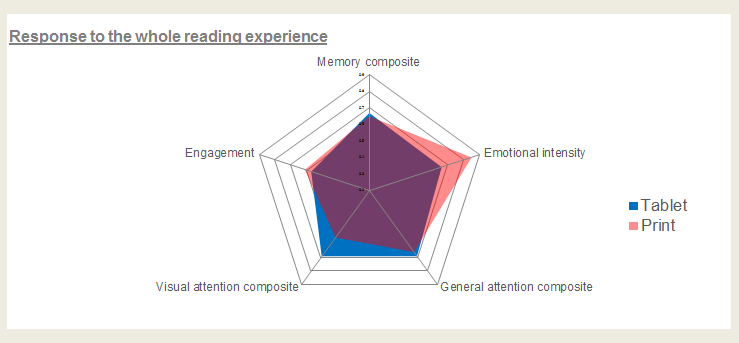Comparing Print and Tablet Newspaper Reader Behavior
Amongst many in the media world, there is a common belief that newspaper content and advertising produce different responses among print and digital readers, and advertisers tend to regard digital readers as a less engaged and therefore lower value audience. Therefore, as people migrate to digital platforms the traditional business models for newspapers are being challenged.
Neuro-Insight’s client in this study, NewsUK, had a different perspective. NewsUK publish a number of newspaper titles in both print and online formats, and their belief was that reading behavior is driven less by the platform itself and more by content and the way it is presented; therefore advertisers should value both audiences equally. Earlier research from NewsUK had supported this view, and they wanted an objective way of better understanding readers’ responses to print and tablet editions. Specifically, they wanted to look at whether people had the same level of involvement in the content, whether it elicited a similar emotional reaction and whether people were more likely to remember what they had read based on the platform used. This was the context in which the research project was undertaken./p>
NewsUK were wary of research based on claimed behavior, knowing that it was difficult for people to self-identify and report on differences in reading patterns based on the reading platform used. Specifically, most conventional research is language-based and therefore dominated by responses experienced in the left hemisphere of the brain, where most speech capability lies. Inevitably, this tends to underplay elements of behavior driven by right-brain responses, dealing with more global or “big picture” thinking. For this reason they chose neuroscience as the methodology for the project; specifically the Steady State Topography approach used by Neuro-Insight.
The study involved a sample of 150 regular Times readers (split evenly between print and tablet readers). They were convened in small groups in a comfortable environment, where they read that day’s issue of The Times on their preferred platform. Whilst they read for 30 minutes, specialized headsets were used to monitor activity in different areas of their brains, and the reading activity of each respondent was individually filmed so we could link, on a second-by-second basis, what they were reading with corresponding brain activity. The most important metric used in the study was Long Term Memory Encoding (LTME); the process by which stimuli are stored into long-term memory. Previous work by Neuro-Insight and others has demonstrated a clear link between LTME and subsequent decision-making; indeed, it has been shown to be a better predictor of behavior than more conventional measures such as claimed recall. The neuro-research was supplemented by focus groups to explore conscious attitudes and behavior, along with Decode Marketing’s Visual Impact Tool, which was used to evaluate the eff effectiveness of different page layouts.

The hypothesis to be explored was that content was more important than platform in driving people’s responses to what they were reading.
Results
The research provided evidence to support this hypothesis. We found differences between the platforms in terms of the physical reading experience, but that take-out from both the print and tablet editions was very similar. Specifically, there was no significant difference in levels of memory encoding response across the two platforms.

The physical experience differed in a number of ways. Those reading the tablet tended to flick more between sections and, unsurprisingly, less time was spent on individual pages. Tablet reading was more visually stimulating (levels of visual attention were up 25% for tablet reading versus print) and memory encoding was relatively stronger in the first few minutes of reading. Print reading elicited a stronger emotional response (emotional intensity was 29% higher than for tablet reading), but was a ”slower burn“ experience; levels of memory encoding took longer to build up but were subsequently maintained at a relatively high level.
However, although there were these differences in the nature of the reading experience, there were many strong similarities between print and tablet readers. The focus groups showed that people applied the same key “rules” when navigating and prioritizing content and, crucially, the neuroscience revealed that levels of LTME were almost identical across the two platforms. This was reflected in very similar levels of recall. This was true for both left brain memory encoding (dealing with detail) and right brain (dealing with macro holistic thinking), and for both editorial and advertising content. Although, on average, readers spent much longer periods of time exposed to print advertising on a given page, mean levels of LTME were actually 10% higher for static adverts on tablets (and this mean level of encoding, reflecting the number and strength of peaks of memory response, is more predictive of impact than time spent).
Conclusions
The research provided clear evidence to support the starting hypotheses that content, and how it is displayed, plays a stronger role than platform in driving reader behavior. There is strong evidence to debunk the common industry view that a simple measure of time spent is a sound proxy for consumer engagement and, by extension, a predicative measure of effective advertising. The results of the study have led to a major editorial investment in developing a new edition led website edition of The Times, and NewsUK is also evolving the tablet edition to deliver a better overall design and reader experience.
The research has provided strong evidence that newspaper content, delivered in similar ways on print and tablet, will deliver similarly engaged readers and advertising outcomes; and by extension these readers should be valued equally, regardless of platform. More broadly, the research has shown that some of the proxy measures currently used to measure advertising effectiveness, such as time spent, are too simplistic and fl awed. With an ever-intensifying drive to demonstrate advertising ROI, we hope this research plays an active part in provoking thoughtful and open discussion about some of the fundamental foundations of current industry thinking around advertising effectiveness.